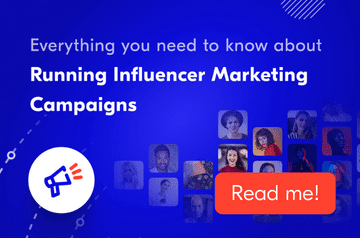Influencer marketing is one of the most versatile strategies out there. Every campaign can be 100% adapted to your industry and audience to help you achieve your goals. Each campaign is different, this means there is no set script for how to run an influencer marketing campaign. However, there are some common steps that all marketers should keep in mind for the smooth running of a campaign. In this article, we’ll reflect on a typical timeline for an influencer marketing campaign and highlight 7 key steps to follow.
How to run an influencer marketing campaign?
First you start with your strategy and goals, then you can move on to influencer recruitment, onboarding, then content creation and finally, reporting. The typical timeline of how to run an influencer marketing campaign can be summarized in these 7 steps:
- Set your goals & strategy
- Decide the type of campaign you’ll run
- Identify influencers and recruit them for your campaign
- Onboarding: create briefs and contracts
- Your influencers produce content
- Content is published and amplified across channels
- You measure the results of your campaign
Strategy, goals & KPIs
Before you start browsing influencer profiles and sending emails, you need to define your strategy. Your influencer marketing strategy should help you to know what your goals are, and the actions needed in order to achieve them. In short, it’s your recipe for success and without a clear strategy to guide your decisions, you’ll struggle to stay on track when you launch your campaign.
- Decide your goals
Ask yourself what exactly you want to achieve at the end of your influencer campaign? You may choose to focus on one goal or decide to have several. The more specific you can be about your goals, the better you can design your influencer campaign to deliver results. Your campaign goals may focus on brand awareness, brand engagement, conversions, or boosting loyalty.
- Choose your KPIs
Now you’ve set your goals, choosing key performance indicators (KPIs) will help you to know if you have successfully achieved your goals. For each aim, assign a key performance indicator, i.e. a data point that you can measure during and after the campaign to determine your success. KPIs for awareness might include impressions or views, whereas KPIs for conversions will include the number of sales, number of clicks, or number of subscriptions.
- Plan your strategy
With your goals and KPIs in mind, you can decide how working with influencers will help you grow your brand. You should decide your target audience, your chosen social media channels, and what type of influencers you should work with to build a framework for your campaign.

Choosing your campaign type
The next decision to make is what type of campaign to run? You’ll need to think about content formats, social media channels, and influencer compensation. Your campaign type should be directly tied to helping you achieve your goals. For example, if your goal is to drive online sales of your limited edition hand cream then you could run a promo code campaign, offering influencers 10% of the profits from the sales they generate.
Some of the most types of campaigns include:
- Sponsored influencer posts
- Unboxing and product gifting
- Giveaway competitions
- Affiliate marketing
- Product collaborations
- Seasonal campaigns
- Brand ambassador campaigns
Influencer selection & outreach
With your strategy set, now the action can begin! You can start identifying creators for your campaign by using your brand’s target audience demographics and analyzing creator performance metrics to choose the influencers best suited to your needs.
It’s important to use the right tools to run your influencer campaigns. You’ll save valuable time and resources by investing in the right software and integrations to get the most from your campaign. Find influencers at scale with Upfluence’s influencer search tool. Identify creators from a database using 20+ advanced search filters. Alternatively, you can identify influential people within your own brand network by using Upfluence’s influencer matching tool to analyze the social reach of your customers, subscribers, or followers.
Once you have a shortlist of suitable influencers, outreach can begin! Remember to introduce your brand and products, put forward a convincing value proposition, and share details of your compensation offer. Get outreach tips and influencer email templates to help kickstart your campaign.

Briefs & contracts
The next step in how to run an influencer marketing campaign is to onboard your chosen influencers by sharing your campaign brief, negotiating compensation, and signing a contract. You should create a brief for every new campaign that shares important details about content production and message tone, dos & don’ts, as well as a timeline. A successful brief is informative while getting the influencer excited to work with your business.
Negotiation is an important part of any partnership. You should aim for mutually beneficial partnerships which balance the amount of effort needed from the influencer with the compensation they’ll receive. There’s no official rate for influencer content, so try to understand influencers’ costs when making your offer. Take into account factors like location, industry, and brand affinity as well as campaign variables such as length and equipment required when deciding how much to pay.
The final stage of onboarding is creating an influencer contract. You will find that most influencers expect a contract nowadays, like freelancers. So don’t be intimidated – a good contract will help establish terms, reduce risks, and set the foundation for a transparent, professional partnership. By setting and agreeing to expectations you make sure both parties are on the same page.
Content production
Once you’ve ironed out the final details of your campaign planning and contract, it’s time for your influencers to put their creativity into action! For marketers running the campaign, you’ll need to make sure your influencers have everything they need to start making content for the campaign. This means shipping product samples, sharing campaign guidelines, and generating promo codes or affiliate links if needed.
Before creators begin publishing their content, allow time for content review and validation if that’s important for your brand. Upfluence’s influencer campaign workflow tool allows you to easily manage sending briefs, contracts and validating content from one dashboard.

Content amplification
Your campaign is live! You can maximize the success of your campaign by amplifying influencer-generated content during and after the campaign. By using your brand’s owned channels such as social media, website, and newsletters to reshare campaign content and promote your collaboration you’ll get the content in front of even more people.
You may also decide to promote your best influencer content through paid media campaigns. Buying additional media space should be a key consideration when planning your initial campaign budget. Repurposing content on paid channels is a great way to get additional value from the influencer content you have already paid for, just remember to include content ownership or whitelisting permissions in the contract!
Campaign measuring and reporting
At the end of your influencer marketing campaign, you’ll need to measure your KPIs (chosen at the start of your campaign) to analyze your campaign’s performance. You should track the KPIs that correspond to your campaign goals and evaluate whether your campaign has successfully reached your goals.
However, campaign measurement shouldn’t only happen at the end of the campaign. Using a tool such as Upfluence to run your campaigns means you have access to campaign analytics in real-time so you can easily make adjustments if needed to keep the campaign on track.
Tracking results is important in order to help you calculate return on investment and earned media value. This will show the direct results of your investment in influencer marketing and whether it’s worth repeating.
Analyzing individual influencers’ performance will also help you decide which influencers to partner with again in the future. You should nurture long-term partnerships with your best-performing influencers to ensure your ROI remains high across future influencer marketing campaigns.
If you’re running a revenue-share campaign, then measuring the number and value of sales will help you to accurately calculate and pay your influencers.
That’s how to run an influencer marketing campaign! This step-by-step guide shows you the steps to take to go from strategy to action. Influencer campaigns can take many forms, yet these campaign milestones remain the same and can be adapted to your needs.
Get additional tips and expert insight on how to run campaigns with our guide, Everything You Need To Know About Running Influencer Marketing Campaigns.

























